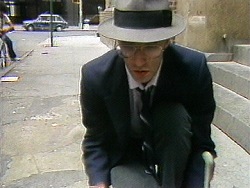Kit Fitzgerald and John Sanborn
Biography
Working as a collaborative team from 1976 until 1982, see Kit Fitzgerald and John Sanborn created works that broke new ground in their dynamic fusion of video art and television tactics. Rapid-fire, percussive editing and the kinetic use of post-production effects defined their energetic juxtapositions of visual, musical and conceptual themes. Manipulating the interplay of time, sound and image, they crafted a televisual language related to the compositional techniques of music: theme and variations; rhythm; counterpoint. Key to their work was the notion of "visual humming," the imagic equivalent of a musical "hook." Olympic Fragments (1980) is a classic of the tour-de- force editing style that became their signature.
Transforming everyday gestures with time-lapse, dissolves, staccato edits and disjunctive image and sound, their works of the 1970s challenged perceptions of illusion and reality. With Still Life (1981), they explored innovative strategies of nonlinear narrative with fragmented, textured layerings of image, sound and text.
Fitzgerald and Sanborn were in the vanguard of artists exploring the relationship of music, performance and video editing techniques in the early 1980s. In 1982, with Antarctica, they began working with avant-garde musicians to produce experimental music videos, a form that dominated their later work.
As collaborative videomakers, Fitzgerald and Sanborn received numerous awards and commissions, including artist-in-residencies at the Synapse Video Center, Syracuse, and the Television Laboratory at WNET/Thirteen; a commission from the 1980 Olympic Commission; and grants from the National Endowment for the Arts and the New York State Council on the Arts. Their videotapes have been exhibited internationally at institutions including The Kitchen, New York; Institute of Contemporary Art, Los Angeles; National Gallery of Art, Canada; Centre Georges Pompidou, Paris; The Museum of Contemporary Art, Chicago; The Museum of Modern Art, New York; and the Whitney Museum of American Art, New York.
